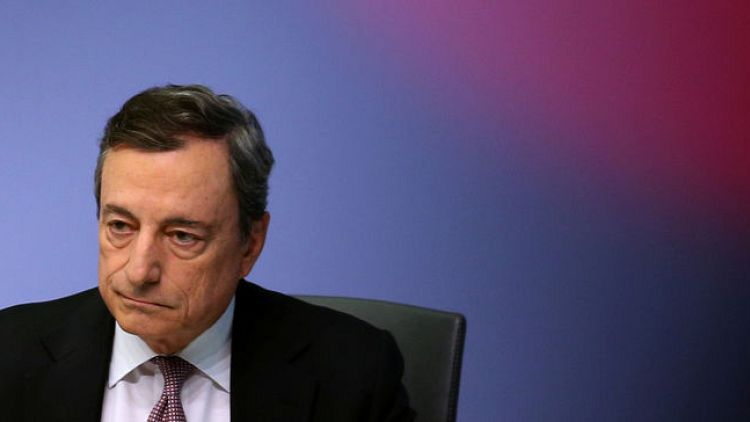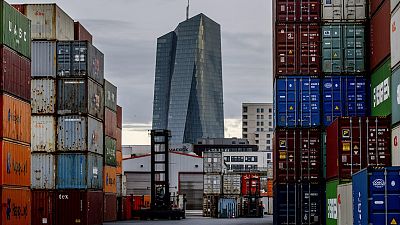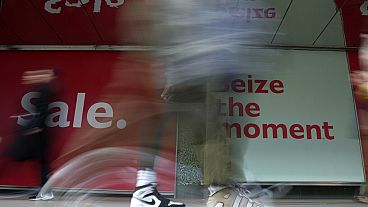By Balazs Koranyi
FRANKFURT (Reuters) - European Central Bank President Mario Draghi - often credited with single-handedly saving the euro during the worst of its crisis - is expected to perform more magic next week in his penultimate meeting in charge.
The euro zone economy is ailing and inflation is worryingly weak, putting pressure on the central bank to prop up the 19-member currency bloc, much as it has done time and again over the last decade.
Draghi is expected to oblige and deliver a fresh stimulus cocktail next Thursday, not least because others, particularly the Federal Reserve, are also easing.
But the hard part will be putting the package together.
The ECB has a wide range of tools at its disposal, but each has complications, from questionable efficacy and big side effects to outright opposition from certain key policymakers.
The problem is that the bloc's biggest troubles are outside the central bank's control: no amount of ECB stimulus can deliver a trade deal between the United States and China, boost Chinese growth, or get a Brexit deal signed and implemented.
So the best Draghi can hope for is to prop up confidence long enough for governments to do their job.
This is a dangerous gamble, some of his colleagues argue. The ECB has exhausted most of its firepower through years of stimulus, so it needs to chose its fights carefully and preserve its weapons for a real crisis.
But Draghi is likely to argue that imported troubles are already affecting the domestic economy, raising recession fears. Plus market expectations for stimulus are so high that a modest package would risk disappointing, pushing borrowing costs higher, not lower.
QE OR NOT?
The most contentious point in next Thursday's debate will be whether to restart bond purchases, commonly known as quantitative easing.
This is the ECB's most powerful weapon, but over half a dozen policymakers, including the central bank chiefs of Germany, France, the Netherlands and Austria have expressed scepticism about the need for it.
Their argument is that long-term yields, the target of such buying, are already low and the bigger risk was a rise in short-term rates, which are best tackled with rate cuts and a better-formulated guidance on interest rates.
Draghi is still likely to have the votes if he wanted to go ahead with bond purchases, but opposition from the bloc's biggest economies could be politically damaging.
Which way he goes is unlikely to be known even to other policymakers until just before the meeting, as has become customary during times of stress.
But without bond buys, the package is unlikely to be seen as powerful enough and risks disappointing markets.
A compromise may be to approve a relatively small scheme to cement current financing conditions. Smaller buys could also let the ECB re-enter the market without having to modify its existing rules on bond buys, a controversial and legally contentious issue.
(GRAPHIC: Contribution of ECB non-standard measures to growth and inflation 2014-18 - https://fingfx.thomsonreuters.com/gfx/mkt/12/5811/5745/Pasted%20Image.jpg)
"Quite simply, a policy package that does not include QE will have no chance of closing the gap between the ECB’s projection for inflation at the end 2021 and the ECB’s inflation aim," ABN Amro said in a note.
An intangible argument for a more powerful package is to solidify Draghi's legacy. With Christine Lagarde taking over on Nov 1, the Sept 12 package may be Draghi's last big move to steer policy and cement his role as the champion of the euro.
At the other end of the spectrum, a rate cut appears to be the least contentious move, even if that also comes with complications.
While a rate cut would lower short term corporate borrowing costs, the ECB's deposit rate is already at a record low of minus 0.4%, so a 10 or a 20 basis point cut would immediately hit bank profits.
Commercial banks park excess reserves -- more than 1 trillion euros now -- at the ECB, so they essentially pay a fee for hoarding liquidity.
Raising this fee risks thwarting lending, so the ECB is likely to compensate banks by exempting part of their cash from this charge through a multitiered deposit rate.
While this will mean an immediate boost to banks, it's small and would disproportionately benefits banks in France and Germany, critics argue.
Another tool is to tweak the bank's interest rate guidance, better defining the conditions needed before rates can rise. Such a "reinforced" guidance would push out rate hike expectations even further and would spare the ECB from having to modify this guidance every few months.
"Given the cause of the slowdown, it would be a mistake to expect monetary policy to do everything," French central bank chief Francois Villeroy de Galhau said in a recent interview.
"The ECB's monetary policy is doing its duty, but it can't do everything, and it certainly can't perform miracles."
(Reporting by Balazs Koranyi; Editing by Hugh Lawson)



